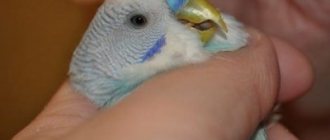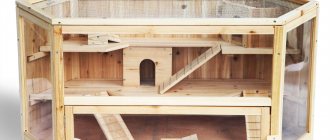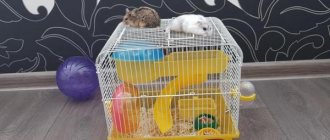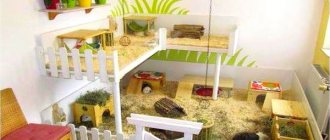A hamster's cage is not only a place to keep him, for him it is the whole world, the house where he lives. As in any home, the cage must be tidy, clean, comfortable and dry.
Reference. The hamster is a clean rodent that is not prone to living in dirt. If you do not clean your animal's house, this can lead to the development of various diseases, so do not be lazy and clean the cage regularly.
How often do you need to clean a hamster's cage and how to do it correctly?
Hamsters are clean animals.
Cleaning an animal's home is an important part of pet care. A dirty and untidy cage can cause illness in a little fidget . When the owner wants to surround the pet with care and love, he keeps the animal’s house in perfect order.
Every cleaning in a hamster’s cage is a shock for the animal, because they are used to making things cozy in their own way. How to get rid of the smell of a hamster in a cage without harming it?
What can you use to make a home for a Syrian hamster?
If it is not possible to purchase a cage, you can make it yourself. The following designs are possible:
- A good solution would be a food container. Using it, you don’t have to worry about your pet chewing through the walls. There will also be no problems with ventilation.
- The mink is made by analogy with the animal’s natural home. The disadvantage of such a home is that it is poorly ventilated.
- You can use an aquarium. Its advantage is that the sawdust will not fly in different directions and the animal will not be able to easily get out, but the aquarium is not ventilated enough, which is a disadvantage.
- From a ventilation point of view, the most optimal solution is lattice cages.
Homemade hamster cage
How often should you clean a rodent's house?
An important question is how often you need to clean your hamster’s cage and remove old food and waste from his house. Let's answer it right now.
The cage is washed with soda solution 2-3 times a month . The litter changes as it becomes dirty and produces an unpleasant odor. When cleaning your hamster's house, you shouldn't completely throw out the old litter and put in a new one. Without the presence of familiar odors, the animal can become disoriented.
If the home is equipped with labyrinths, tunnels and houses, then you need to make sure that leftover food does not accumulate in them, which the hamster hides in reserve. Cleaning a hamster cage with pipes is carried out according to the same algorithm. It is also necessary to wipe all items from dust and dirt.
Do-it-yourself cage for dzhungarika
If you don’t like the idea of buying a cage, you can make it yourself. It is best to make a cage from a food container.
Tools and materials
To make a home, you need to prepare tools: a marker for marking; cutter for cutting holes; hot-melt gun with hot glue.
The materials you will need are: a food container, a metal mesh - 4 pieces the size equal to the sides of the container and plexiglass.
Step-by-step instruction
Making a cage for dwarf birds with your own hands is not difficult. To do this you need:
- Using a marker, mark lines on all sides of the container and lid along which holes will be cut. The margin around the perimeter on all sides should be about 4–6 cm;
- cut holes in the container along the marked line with a milling cutter;
- glue the metal mesh to three sides and the lid of the container with a heat gun, while fastening the parts is done on the outside of the structure so that the animal does not get hurt on the edges of the mesh;
- Glue the glass to the remaining side with hot glue.
The dungeon cage is ready for use. Its design will allow you to observe the hamster through plexiglass, and the presence of a mesh creates constant access of fresh air inside.
Reference! To avoid the formation of debris around the container, you can place it in a cardboard stand 10-15 cm high.
Cage tray
The cage tray must be deep enough. If you set out to breed hamsters, you should know that babies are very mobile from birth and if the tray is low, the babies will fall out of their homes. Deep trays are good because less debris will fall out during active games.
You can make a second floor in the cage
How to make a second floor in a hamster cage
A two-story cage for a dwarf is not only additional free space, but also an opportunity to equip the cage with various accessories. To install the second floor, you need to meet some requirements:
- the distance between floors should be 20-22 cm, such that the running wheel rotates freely, but should not be more than 30 cm so that the animal does not suffer if it falls;
- make the shelves of the floors from plastic, since food will fall through on the metal grate, and besides, it is inconvenient for the animal to run on them;
- if the bottom of the second floor had to be made from a lattice, then you need to cover the bottom with cardboard, which needs to be changed as it gets dirty.
How often should you clean the cage?
To maintain a healthy atmosphere inside your home, it is necessary to carry out regular cleaning.
Every day you need to do a spot cleaning of bedding that is contaminated with hamster excrement, food or water. A complete cleaning of the home is carried out every 2-3 weeks. To do this, you first need to temporarily transplant the hamster into any convenient container, change the bedding material to clean one, and leave the uncontaminated part so that the animal can hear its smell.
Wash the tray with warm water and baby detergents. Wipe the rods thoroughly with a sponge soaked in water. Wipe all accessories in the cage with a dry cloth. Wash and dry the feeder.
Attention! The food reserves hidden by the hamster do not need to be removed, since not finding them, the animal will suffer a great shock.
Only spoiled food is removed from the cage.
After cleaning the home, all items must be returned to their original places.
Important! Cages for dwarfs must be well ventilated so that the toxic odor of ammonia does not accumulate in them.
A two-story cage is chosen for one or two jungarians
Cleaning tools
If you start cleaning the cage, then you need to do it carefully. It is important to follow the order of actions. Inspect the room where the pet lives. This is necessary to assess the scale of the work and identify the dirtiest corners. Poor cleaning, which leaves behind dirt, provokes the appearance of pathogenic microbes . Without waiting for general cleaning, clean the following daily:
- The animal's toilet area. Here the litter gets wet more than at other points, and droppings also accumulate.
- Uneaten remains of food that the animal scatters around the cage.
- The water needs to be replaced every day. The bedding on which the drink falls is removed and freshly laid.
Dirty walls are the culprits of the unpleasant odor that the cage emits. In this case, you will have to clean the entire space of the house.
The preparatory stage is no less important. It consists of selecting equipment and cleaning products that will be needed for the job. This must be done so that during the process you are not distracted by searching for the right tool. To work you will need:
- A cloth for wiping the cage and internal accessories.
- Detergent or soap that does not contain aggressive substances such as bleach. Such components can cause irreparable harm to a little furry. It is better if you buy a product designed for washing cells in a specialized store .
- Clean filler to replace the old one.
Before harvesting, the animal will have to be transplanted to another safe place. High-quality cleaning of the cage is possible only without its occupant.
Stages of cage cleaning
Now let’s look in more detail at how to clean a hamster’s cage. As already mentioned, before starting work, transfer the hamster. Choose a clean box or container where he won't escape.
You can use the ball for a walk. In this case, you need to do the cleaning quickly, it is advisable not to delay it for more than half an hour. Otherwise, the animal will get tired and nervous. Next, do the following:
- Remove all items from the house: cups, toys, structures. The contents must be washed thoroughly and dried well with a clean rag or towel.
- Remove the filler.
- Treat the house well from all sides.
- Add fresh bedding.
In addition to the main filler, leave a few clean paper napkins for the animal. They will be useful for your pet to make his home comfortable after your intervention.
You shouldn’t wait until you notice an unpleasant smell coming from the house. If cleaning is done infrequently, the cage can become unsanitary, and a stale smell makes the hamster feel discomfort and can cause viral diseases.
To achieve the best result, you need to restore order using a solution of water and washing liquids. Dishwashing detergents or laundry soap are suitable for the job. Particularly caring owners prefer simple table vinegar to chemical compounds . You can soak individual elements inside the cage in it. You need to leave parts of the house in the solution for 30 minutes, after which you carefully clean off any remaining dirt with a special scraper.
How to decorate a rodent's home for the holidays?
To feel the New Year's mood, the places where pets live are also decorated. Cages with pallets on the outside around the perimeter can be decorated with tinsel. To do this, in some places it needs to be fixed with tape. Then they hang the toys outside the pet’s home. On the outside of the drinking bowl there are areas inaccessible to the hamster, which are decorated with snowflakes or balls.
Decorating your hamster's cage before Valentine's Day is also fun. Its outer part is covered with red or crimson hearts. It’s great if an aquarium is reserved for the animal’s home. Decorating it from the outside is much safer than decorating a cage, because in this case the pet will not be able to reach them.
After you have become familiar with the nuances of arranging a hamster's home, buy the animal you like. Give him everything he needs and it will keep him healthy for years to come.
Cleaning a rodent's home after birth
There's a new addition to the house, but the owner doesn't know when to clean the cage after giving birth to a hamster? This also happens.
It is necessary to clean the house after giving birth, after two weeks. While putting things in order, the mother and babies are left inside the home, trying not to disturb them, or they are carefully moved to another place.
They remove the cage in the same way as before, only observing one rule: touching the young offspring with your hands is prohibited . It is important to remember this so that the human smell does not remain on the babies. If this is not done, the mother may abandon her cubs. It happened that a hamster ate the offspring that a person touched.
Recommendations for cleaning a cage with newborns:
- Wear disposable gloves.
- Taking the offspring by the scruff of the neck, as animals carry their children, carefully move them to a safe place.
- Send mom after the kids.
- Clean the cage in the usual way.
- Putting on gloves, we return the offspring together with the parent to its place.
If you can move the babies with the bedding on which they were lying, then it is best to do so. This procedure will preserve the smell to which hamsters are accustomed.
By learning how to properly clean your furry friend's cage, strictly following the cleaning algorithm, you will ensure cleanliness and order for your hamster, making your baby happier. Maintaining the home in a hygienic condition will provide the rodent with good health , and will save the owner from unnecessary problems and worries.
Don’t forget to keep an eye on the food that the thrifty animal hides in all corners of its shelter. Remember that the drinking bowl is filled as often as the animal requires.
Basic rules to consider when caring for hamsters
There are a number of rules that need to be taken into account when caring for hamsters. They are the following:
- The hamster is a solitary creature. It is very important that he lives separately. If you add another hamster to a hamster, they will fight. And in some cases they can even kill each other.
- The hamster's cage should be spacious enough. Its dimensions should be fifty by thirty centimeters. The number of floors can be any.
- The hamster should be able to run a lot. Creatures living in nature are accustomed to increased activity. They move around a lot. Running is in their blood. Accordingly, we recommend purchasing a special wheel for your hamster. It should be large enough in size. To make it convenient for the creature to run. We also recommend buying him a ball. It will be useful for the hamster to walk around the apartment.
- You need to breed hamsters very carefully. Otherwise, you risk causing the creatures to fight if you put them in the same cell. After the hamster gives birth, its offspring will need to be housed. They must be placed in a separate cage. This is quite an expensive endeavor. Because you have to purchase a lot of cells.
How to keep a hamster cage?
It is imperative to place filler in the cage. It can be made in the form of granules. Or maybe corn. In addition, the cage must have:
- Napkins. They must be paper. And also white and odorless.
- Drawing for a nest.
- Wheel.
- Special drinking bowl. It must be suspended.
- A bowl. It is recommended to place special dry food in it.
Other items can be placed if you need them. For example, we are talking about a house. Special toilet. And so on.
Where should the cage be?
The cage cannot be placed randomly. It should stand according to the following principle:
- It cannot be placed in the kitchen.
- It cannot be installed in the corridor.
- It cannot be installed on a balcony.
- It should be placed at a large distance from the windows. And also from the doors.
- It should be placed at a distance of at least two meters from the batteries.
Keep in mind that hamsters are very fragile creatures. They can get sick from the slightest breath of wind. Accordingly, they need to be placed in the most favorable part of the room. Then they will be safe.
The cage must be placed in a quiet place. Keep in mind that hamsters have very sensitive hearing. Because of this, they get nervous when they hear something loud.
Keep in mind that sharp sounds provoke stress in hamsters. This has the effect of reducing the creature's lifespan. During the daytime, hamsters are in a state of sleep. And your task is not to wake them up.
The cage must be kept in a place that is ventilated
At the same time, it should not be placed in a draft. Be sure to place a specialized thermometer next to the cage. With it, you have to monitor whether the temperature in the room is optimal.
For example, hamsters should be kept in a temperature range of twenty-two to twenty-eight degrees. Not lower and not higher. In the first case, the hamster will freeze. In the second, it will overheat.
Cleaning the hamster's cage
Cleaning the cage is an important part of caring for your hamster. The health of the pet depends on this. On the one hand, you need to clean often to always maintain cleanliness and order. This way there will be less chance of catching some disease. But every cleaning is stressful and even stressful for the hamster. He put everything in its place, his smell is everywhere. But here, in a short time, everything is different, the smell has practically disappeared, there has been a rearrangement inside, some of the supplies have disappeared somewhere. This situation is also harmful. So we need to find a middle ground? How to clean a hamster's cage?
Cleaning is done every 2-4 weeks. Before you begin, you must know the structure of your home. Like in humans, its cell is divided into unique zones. In one corner there is a toilet, in another there is a gym, and there he has a house for sleeping. Pay special attention to the pantry. There the pet stores all its reserves. Destroying them means dooming the fluffy to serious stress. It's like an apartment robbery for us. Therefore, when cleaning the cage, only spoiled food should be removed. In the case of several rodents in one cage, try not to mix their supplies.
Failure to study the main signs and symptoms of diseases
It is imperative to know the symptoms of certain diseases. After all, prevention is the best treatment. A timely visit to the veterinarian can save your pet and help avoid many problems.
It is worth paying attention to changes in the behavior of your furry pet. Reasons for concern may include:
- excessive activity and lack of sleep;
- lethargy;
- lack of appetite;
- sadness.
If you find this, be sure to contact a specialist.
Where to start cleaning your home
The first thing to do is remove the animal itself. During this time, it can be kept in another cage or carrier; some use a regular jar. First, we change the pallet with bedding. It is important not to touch anything that was constructed by the animal. He put a lot of time and effort into each design. Try to minimize your direct interference in his life. How to clean a hamster cage? The pan must be washed with plenty of waste water. If the contamination is serious and this method does not work, you need to take a special hamster shampoo or baby detergent. Whether an allergic reaction will occur depends on what you wash the hamster's cage with, since chemicals are contraindicated for rodents. In children's products, its amount is kept to a minimum. Ideally, of course, you need to wash everything manually; we use additional products only in case of serious contamination. For preventative purposes, you can additionally disinfect your home. How to clean a hamster cage? As well as other utensils, such as a razor. Girls will understand me. The only caveat is that it does not use detergents. Now he is replacing the old bedding with a new one. It is important to not change all of it, we leave some of the old one so that the smell of the hamster does not completely disappear from the home. It is important to know how to stop a hamster from biting so as not to be attacked.
Why does a hamster bite
Hamsters, including domestic ones, are primarily rodents. It is in the hamster's genes to bite any object that catches its eye. Hamster teeth grow quickly and need to be ground down using twigs, roots or mineral stone.
In the absence of this, the animal gnaws on everything, including the owner’s hands. You are picking up the hamster incorrectly - it is preferable to place your hand so that the pet can climb on it, or take it from the side, if you take the rodent from above, it will get scared and may bite. Your hands smell like food - be sure to wash your hands thoroughly before handling your pet.
The rodent studies the surrounding space, testing everything to its teeth - in this case, the main thing is not to scare the pet with your scream and switch its attention to another object. The animal is experiencing stress (for example, a change of place of residence) - if possible, eliminate the causes of stress; if this is a move, do not touch the hamster for several days, avoiding cleaning the cage. Pregnant and lactating females may show aggression instinctively in order to protect the offspring - this will pass when the young grow up. During this period, you should not try to pick up the animal.
You can train your hamster to stop biting at home in several stages.
- Use of treats. We take nuts or seeds in our hands and smoothly insert our hand into the cage. The hamster will smell the food and move closer to your hand. At first, we leave the treats in the feeder while the animal gets used to the sight of the hand and the smell.
- When the pet becomes bolder, we wait for him to try to climb onto your hand with a treat. For some time you will need to let him stomp on your palm and eat the treat.
- When this stage has been passed, you can lightly stroke the animal’s back. But under no circumstances touch your head.
- After getting used to all of the above actions, you can try to pull the hamster sitting in the palm of your hand out of the cage and pick it up.
It is important to do everything slowly and carefully, with a lot of patience. Always approach the cage in such a way that the rodent can see you. Attempts to take him from behind will lead to aggression and repeated bites.
Second weaning method
There is another way. Using a scoop or similar object, you need to remove the hamster from the cage and place it on the bed or floor - any flat surface. First, let the animal walk around on its own so that it can sniff everything and feel safe.
Note! Before releasing the rodent from the cage, prepare an area for it in advance, fence it off on all sides so that the hamster does not escape. Finding and catching a rodent in an apartment is quite difficult! After a while, block the rodent's path with the back of your hand
The outer part of the palm will look more like a regular barrier, while the inner side will frighten the animal. A rodent may associate splayed fingers with the fangs of a predator - this is an instinctive reaction
After a while, block the rodent's path with the back of your hand. The outer part of the palm will look more like a regular barrier, while the inner side will frighten the animal. A rodent may associate splayed fingers with the fangs of a predator - this is an instinctive reaction.
Why is it important to keep the cage clean?
By nature, hamsters are very clean. Wild relatives of domestic hamsters do everything to ensure that no foreign odors come from their homes and fur.
Interesting! Any smell is a bait for a predator, so in the process of evolution, hamsters have learned to carefully care for their fur and fur.
The possibilities of domestic hamsters are limited, at least because they do not live in burrows, but in cages. Responsibility for maintaining cleanliness and optimal living conditions rests with the owner.
Why is it important to keep your cage clean:
- Over time, the cell litter becomes damp and becomes fertile soil for the proliferation of pathogenic bacteria.
- If you do not clean it regularly, a strong, unpleasant odor will emanate from the cage and the hamster.
- Hamsters sleep buried in the bedding, so a dirty cage is a direct path to various inflammatory processes and deterioration in the quality of the coat.
- When your hamster smells bad, he is constantly stressed. The pet instinctively worries that it may become a victim of a predator.
Cleaning the cage is not the most pleasant pastime, but it is an essential aspect of caring for pet rodents. In addition, by following basic instructions, you can get rid of the unpleasant odor that comes from the litter.
What can you use to make housing for a Djungarian hamster?
You can make housing for a dzhungarik with your own hands. You just need to choose a non-toxic and durable material. The house can be made from:
- wooden planks or planks;
- coconut shells;
- organic glass;
- plastic;
- thick cardboard
The hamster will feel best in a wooden, cardboard or coconut shell house, but he will constantly sharpen such a house with his teeth. And the second disadvantage of such houses is that pathogenic organisms formed after food residues and urine will accumulate in natural materials.
A wooden house cannot be varnished or painted, as this will cause poisoning to the hamster. A house made of plastic and organic glass can be more durable and safer.
Has your hamster ever lived in a wooden house?
You can make a cage with your own hands
Where to move a hamster during cleaning
The first question that needs to be resolved is where to move the hamster during the cleaning period. Ideally, you need to have a second, small cage in which the pet can rest without unnecessary stress.
If there is no second cell, it can be placed in:
- In a plastic container with a lid. You first need to make several holes in the lid. A closed plastic container should never be left in direct sunlight.
- Three-liter jar. A quite tolerable shelter for a hamster, based on cleaning within 30–60 minutes. Like a plastic container, the jar should not be left in the sun.
- Bath. By closing the drain hole and laying towels on the bottom of the bathroom, you can calmly start cleaning and not worry that the hamster will escape.
Important! It is not recommended to leave the hamster in a cardboard box while cleaning, as the pet can easily chew through the wall and run away.
Equipment and cleaning products
You may need equipment and cleaning products:
- Viscose napkins.
- Old toothbrush.
- A large basin in which you can soak accessories. In order for the tunnels, wheel, house and other accessories to be washed better, it is enough to hold them in a soap solution for 5-10 minutes. Wooden products should not be soaked!
- Disinfectant solution for cleaning rodent cages.
How to play with a hamster?
Hamsters love to crawl through cardboard tubes (toilet paper or toilet towels) and chew wrapping bags. You can place large wooden cubes on top of each other and make a labyrinth out of them. Try offering wooden spools or tree branches for your hamster to chew on or climb on.
Interesting materials:
What is speech audiometry? What is a site redirect? What is a regular and charter flight? What is an advertising agent? What is a steering belt? What is handicraft? What is profitability? What is reposting a publication? What is a repost in like? What is a decision of the court of first instance?
Frequency of cage cleaning
Before you start cleaning, look carefully at your hamster's cage. The frequency of cleaning the cage will depend on the current condition. Carefully inspect:
- Tray.
- Walls.
- All gaming accessories.
- Feeder and drinker.
Tip: If your hamster's cage looks too dirty, clean it in sections. Global, general cleaning can cause stress for your pet.
It is best to spend 10–15 minutes cleaning the cage several times a week:
- Remove wet parts of the litter. Over time, hamsters choose one place to go to the toilet. The rest of the bedding will remain relatively clean, but one of the corners of the cage will be constantly wet.
- Remove food supplies from the corners of the cage or in the house. Hamsters instinctively stock up, even if they are not in danger of starvation. You will notice that your pet is especially active in storing food in the fall.
- Wash one of the accessories in the cage thoroughly ; the next time you clean it, it will be enough to wipe it.
Important! The water in your hamster's drinking bowl must be changed daily! The drinking bowl must be washed every time the water is changed, especially in hot weather.
The need to carry out general cleaning arises if the walls of the cage are dirty or there is a persistent or unpleasant odor emanating from it.
How to prevent unpleasant odors
A few simple tricks will help reduce the time spent cleaning up after your hamster. It is impossible to do without this, of course. But every owner of these cute animals can make their life easier and remove the smell of hamsters.
Toilet training your pet
In a habitable house, the hamster usually chooses one corner (usually away from the drinking bowl and sleeping area) to relieve its natural needs. You can put a small tray with filler in this place. The first time the tray is sprinkled with already soiled filler, so as not to frighten the animal. This technique will help make the cleaning process a little easier.
It can be divided into daily and “general” - with washing the entire house, when the smell of hamsters is completely removed.
Choosing the right filler
Corn litter is best suited for hamsters, since it is the type of litter that reliably blocks the smell of urine. With him, you will only have to clean the cage once every 10–14 days. Every week you have to clean out the wood filler (shavings, sawdust, pressed pellets).
Proper cage cleaning
You shouldn’t look for the reason why hamster urine stinks; this fact should be taken for granted. The task of the animal owner is to provide him with decent living conditions.
Stages of cleaning a cage
The stages of cleaning the cage are arranged depending on the volume and scale of the work. Consider the sequence of general cleaning:
- Prepare a bowl of warm soapy water.
- Fill a spray bottle with soapy water.
- Remove all accessories that need to be soaked and place in a basin.
- Remove all litter from the tray and fill it with warm water.
- Use a spray bottle and an old toothbrush to clean the joints of the cage walls.
- Wash the drinker and feeder thoroughly.
While the tray is wet, it must be treated with a disinfectant. After soaking and washing and assembling the cage, you need to wait for it to dry completely. It is better to dry the cage and accessories in the sun.
Cleaning toys and equipment
Cleaning toys and equipment is one of the most difficult tasks, as dirt gets stuck in the joints and fastenings. In addition, if toys are made of not very high-quality plastic, they can “keep an odor.” If the smell remains on the toys even after washing, they will have to be replaced.
Cleaning the walls
Cleaning walls is a long, monotonous, but fairly simple process:
- Hydration. The rods and their joints must be thoroughly sprayed with soapy water.
- Rough cleaning. Using a toothbrush, clean all joints, moving from the corners to the middle of the walls.
- Rinsing. Rinse off the soapy solution under running water or with a napkin.
- Drying. Wipe the bars and joints with a dry cloth, then leave the cage in the sun or draft for 10–20 minutes.
Over time, the paint on the rods will begin to peel off. This process cannot be “started”, otherwise the cell will begin to rust. Places where the paint has come off the rods must be sanded. To protect metal from corrosion, you can use spray paint or primer.
Tray washing
The main purpose of complete cleaning is washing the tray. Particular attention should be paid to corners, sides and wall joints. Even heavy dirt can be removed by first soaking the tray and cleaning the corners with an old toothbrush.
Cleaning the feeder and drinker
Clean the feeder and drinker only with water and a clean cloth. If the feeder is plastic, it can “hold” the smell.
From frequent washing, plastic becomes porous, as a result of which it is very difficult to wash.
Cleaning the toilet
Cleaning the toilet can be done without disassembling and completely cleaning the cage. Moreover, cleaning your toilet 3-4 times a week will make your deep cleaning process much easier.











